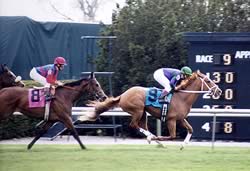In equine athletes, muscle fibers are classified as either slow twitch or fast twitch fibers.
Types of Muscle Fibers
Slow twitch, or Type I, fibers are highly oxidative, meaning they use aerobic metabolism to produce energy-generating ATP. These fibers are used for endurance and are said to be “fatigue-resistant” because they are capable of reducing the toxic end products of metabolism, such as lactate.
Fast twitch, or Type II, fibers are subdivided into Type II A and Type II B fibers. 
- The Type II A fibers are both high and low oxidative. These fibers are capable of utilizing both aerobic and anaerobic metabolism to produce energy for work. Type II A fibers are used to maintain high speed or jumping.
- The Type II B fibers are low oxidative, meaning they are highly anaerobic. These fibers are used to give the horse speed.
Neither class of Type II muscle fibers has the ability to reduce lactate as do Type I fibers; therefore, fatigue is reached in a shorter time.
Differences in Muscle Fiber Types
Distinct differences exist in the ratio of Type I to Type II muscle fibers among breeds of horses, more specifically, among types of performance. Quarter Horses and Thoroughbreds have a lower proportion of Type I muscle fibers when compared to Arabians or Andalusians. This difference is because the racing or timed rodeo events of Quarter Horses and Thoroughbreds are short-term, high-intensity events that utilize anaerobic metabolism by fast twitch fibers. The endurance rides associated with of Arabians and Andalusians are long-term, submaximal intensity aerobic events; therefore, more slow twitch fibers are required.
Authors: Craig Wood, University of Kentucky; Ashley Griffin, University of Kentucky


